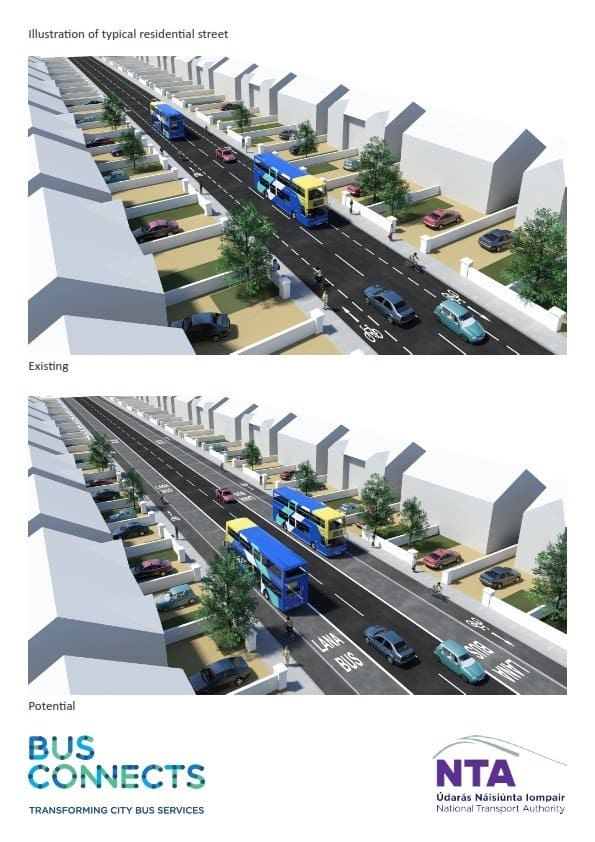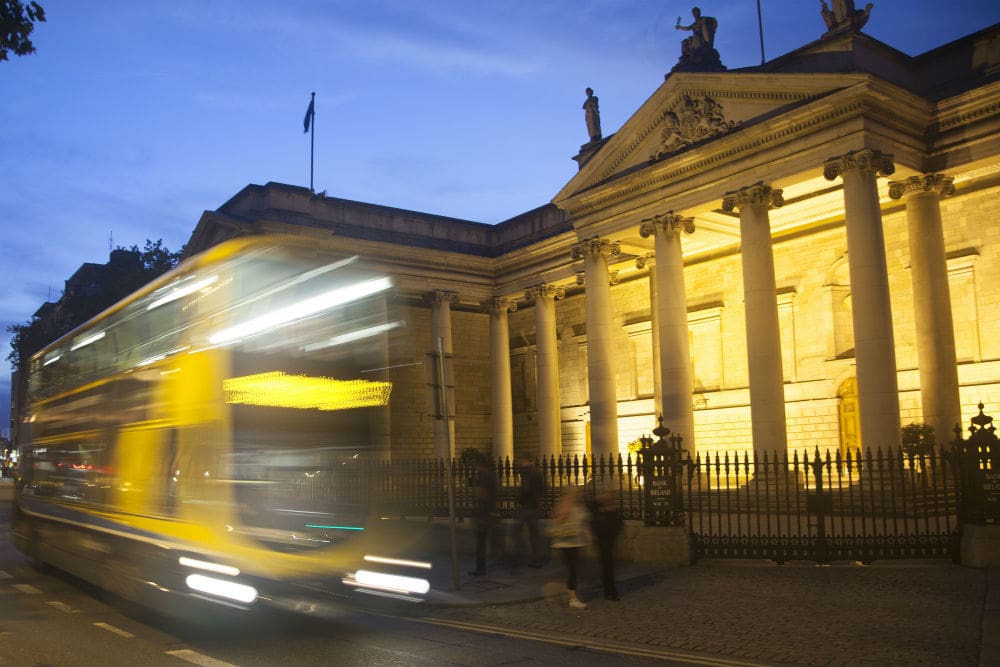You can now have your say on four of the new bus corridors proposed in the BusConnects programme – the overhaul of Dublin’s bus network.
The plan would see the city’s bus routes largely based around 16 dedicated Core Bus Corridors. These are key commuter routes where buses will have priority, with 230km of bus lanes and 200km of cycle lanes along them. The aim is to cut bus journey times by around 20-30 minutes and avoid the growing traffic congestion in the city.
The National Transport Authority has published their ‘Emerging Preferred Routes’ for four of the new corridors. These are the routes that the corridors are most likely to take, but aren’t yet set in stone. A public consultation is now open, so that people who may be affected by the changes can have their say. The four corridors in the first phase are from Clongriffin, Swords, Blanchardstown and Lucan to the city centre.
The preferred routes
Keep in mind that the Emerging Preferred Routes are for the new core bus corridors – the roads that will have priority bus lanes – rather than individual bus routes. Several buses will serve each corridor, and some bus services will travel off the corridors to serve the surrounding areas.
Clongriffin to the city centre
The proposed bus corridor would start at Clongriffin DART station and continue via a newly-extended Clongriffin Main St to join the Malahide Rd north of Clarehall. It will then turn onto the Malahide Rd as far as Fairview to link up with a separate Clontarf to city centre cycle scheme (most likely routed via Fairview, North Strand and Amiens St to finish on the North Quays).
Swords to the city centre
The corridor would start in Swords at Pinnock Hill on the Dublin Rd (R132), and continue straight past the Airport R/A, onto the Swords Rd, through Drumcondra and as far as the North Frederick St jct on Dorset St. It would then continue on North Frederick St and Parnell Square, and join the existing bus lanes in the city centre.
Blanchardstown to the city centre
The bus corridor would start on Blanchardstown Rd on the Corduff side of the N3 flyover. A new terminus/passenger interchange is proposed at Blanchardstown SC, so the bus corridor will link with that and continue via Snugborough Rd onto the N3. From there, it’ll proceed straight down the N3 and Navan Rd as far as Old Cabra Rd and travel through Stoneybatter to get to the North Quays.
Lucan to the city centre
The Lucan corridor is a relatively straight line – starting on the N4 at J3 Lucan and continuing straight through the Chapelizod Bypass, Con Colbert Rd and St John’s Rd West to join the North Quays near Heuston Station.
You can see the full details for each route here. Artist’s impressions of how residential (on the left) and urban (on the right) streets could look are below – click to enlarge.

How will it affect traffic?
Overall, the plan aims to cut congestion by providing more buses on faster journeys. For car traffic, the biggest difference will be changes to the road layout along the new corridors. Several roads will be widened to facilitate new bus and cycle lanes. A number of junctions will be upgraded to give buses priority, some slip roads will be changed to left-turn lanes and a few roundabouts will change into junctions (including the Ashtown R/A on the Navan Rd and the Pinnock Hill R/A in Swords). In a limited number of cases, a road may lose a general traffic lane to gain a bus lane (such as Blanchardstown Rd South) and some turns will be banned (including some ‘no left turns’ on Dorset St).
Where roads can’t be widened, there are some proposals for new traffic restrictions. The Old Cabra Rd would be restricted to public transport and bicycles between Ratoath Rd and the NCR (except for residents), Prussia St would be made one-way southbound (with northbound traffic diverted via Aughrim St) and a stretch of the Swords Rd between the Omni Park SC and Shantalla Rd would be made one-way northbound, with southbound traffic taking the motorway at Coolock Lane.
And it’s expected that around 230 on-street parking spaces will be lost, but there will also be some new parking spaces, including in the Drumcondra area.
How will it affect cyclists?
The four proposed corridors in this phase include 31km of new cycle lanes, and many junctions along the routes will be upgraded with cyclists in mind.
On particularly narrow stretches of the route, it’s proposed to direct the cycle lanes onto parallel routes. The southbound cycle lane on the Malahide Rd would briefly take St Brendan’s Ave between Tonlegee Rd and Gracefield Rd, and closer to the city, the cycle lane in both directions would be on Brian Rd, Carleton Rd and Haverty Rd instead of the parallel stretch of the Malahide Rd.
There’s also a proposal for bicycles to use George’s Lane and Queen St instead of part of North Brunswick St, and for a short stretch of the Swords cycle track to be on Shanrath Rd instead of the Swords Rd.
What are the other impacts?
In this phase of the scheme, around 345 properties could lose a portion of their gardens or driveways to allow for road widening. The NTA will talk directly to the owners of these properties over the coming weeks.
Around 500 trees will need to be removed during the works, but these are to be replaced, where possible, at the completion of the project.
When can I have my say?
If you want to have a say on the plans for these four corridors, you have until the 15th of February to make a submission. Full details are here.
What’s next?
The preferred routes for the rest of the corridors will be published early in 2019, with the consultation continuing in phases.
Phase two, running from mid-January to the end of March, will involve the following 6 core bus corridors: Liffey Valley to city centre, Clondalkin to Drimnagh, Greenhills to city centre, Tallaght to Terenure, Kimmage to city centre and Rathfarnham to city centre.
Phase three, running from mid-February to the end of April, will involve the final 6 core bus corridors: Ballymun to city centre, Finglas to Phibsborough, Bray to city centre, Blackrock to Merrion, UCD Ballsbridge to city centre and Ringsend to city centre.
The plans will then go to An Bord Pleanála. Construction is expected to start around 2021, with the project finished by 2027.










